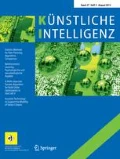Abstract
Designing robotic components and algorithms for exploration and science missions in space and on celestial bodies requires extensive preparation and testing. Due to the extremely high costs of spaceflight and space-capable hardware, design and evaluation iterations need to be performed on earth, using computer simulations as well as real test environments to make predictions about the robot’s performance on the real mission. A variety of ways to simulate single aspects of a robot like mechanical stress or power consumption in great detail are in active use. However, no truly holistic solution that evaluates overall system behavior across a multitude of disciplines has been developed to date. In this paper, we discuss the benefits of such a solution and present our virtual space robotics testbed, a framework that represents our work towards a holistic solution.



Similar content being viewed by others
References
Wetter M, Haves P (2008) A Modular Building Controls Virtual Test Bed for the Integration of Heterogeneos Systems. In: Proceedings of SimBuild, 3rd National Conference of IBPSA-USA Berkeley, California, USA
Dougal RA, Liu S, Gao L, Blackwelder M (2002) Virtual test bed for advanced power sources. J Power Sources 110(2):285–294
Dion F, Jun-Seok Oh, Robinson R (2011) Virtual testbed for assessing probe vehicle data in intellidrive systems. IEEE Trans Intell Transp Syst 12(3):635–644. doi:10.1109/TITS.2009.2034017
Poulakis P, Joudrier L, Wailliez S, Kapellos K (2008) 3DROV: A planetary rover system design, simulation and verification tool. In Proc. 9th International Symposium on Artificial Intelligence, Robotics and Automation in Space (i-SAIRAS), Hollywood, USA
Quigley M, Conley K, Gerkey B et al (2009): ROS: an open-source robot operating system. ICRA workshop on open source software
Bardina J, Rajkumar T (2013) Intelligent launch and range operations virtual testbed (ILRO- VTB). In Proc. SPIE 5091, Enabling Technologies for Simulation Science VII, 141, doi:10.1117/12.486335
Rossmann J (2012) eRobotics: The Symbiosis of Advanced Robotics and Virtual Reality Technologies. In: Proc. ASME 2012 International Design Engineering Technical Conferences & Computers and Information in Engineering Conference IDETC/CIE (ASME GX1576—2012), Chicago, Illinois, USA, Vol. 2, Part B “32nd Computers and Information in Engineering Conference”, pp 1395ff
Rossmann J, Schluse M, Sondermann B, Emde M & Rast M (2012). Advanced mobile robot engineering with virtual testbeds. In Proc. 7th German Conference on Robotics, Munich, Germany, pp 331–336
Roßmann J, Schlette C, Springer M (2012) kinematic robot control for a planetary landing mockup. In: A. Bruzzone (ed.): Proceedings of the 20th IASTED international conference on applied simulation and modelling (ASM 2012), Napoli, Italy, pp 134–141, doi:10.2316/P.2012.776-028
Roßmann J, Emde M, Steil, T, Hempe N (2013) Validierte Sensorsimulation zur integrierten Entwicklung mechatronischer Systeme für zukünftige Weltraummissionen”. In: Gausmeier J, Grafe M, et al (Hrsg.): Wissenschaftsforum 2013-Intelligente Technische Systeme, 11. Paderborner Workshop “Augmented and Virtual Reality in der Produktentstehung” Paderborn, HNI Verlagsschriftenreihe, Vol. 311, pp 219–234 [in German]
Blochwitz T, et al. (2012) Functional Mockup Interface 2.0: The standard for tool independent exchange of simulation models. In Proc. 9th International Modelica Conference, Munich, Germany
Wiens R, et al. (2005) ChemCam science objectives for the mars science laboratory (MSL) Rover. In Proc. Lunar and Planetary Science, 36, pp 1580–1581
Gallant M, Ellery A, Marshall J (2013) Rover-based autonomous science by probabilistic identification and evaluation. J Intell Robot Syst, Springer Netherlands, ISSN 0921-0296, pp 1–23, doi: 10.1007/s10846-013-9818-6
Tompkins P, Stentz A, Wettergreen D (2004) Global path planning for mars rover exploration. In Proc. 2004 IEEE Aerospace Conference, Big Sky, USA
Rossmann J, Schlette C, Emde M, Sondermann B (2010) Discussion of a self-localization and navigation unit for mobile robots in extraterrestrial environments. In Proc. 10th International Symposium on Artificial Intelligence, Robotics and Automation in Space (i- SAIRAS), Sapporo, Japan, pp 46–53
Rossmann J, Sondermann B, Emde M (2011) Virtual testbeds for planetary exploration: the self-localization aspect. In Proc. 11th Symposium on Advanced Space Technologies in Robotics and Automation (ASTRA 2011), ESA/ESTEC, Noordwijk, The Netherlands, pp 1–8
Roßmann J, Springer M, Wantia N et al (2011) Rapid generation of 3D navigation maps for extraterrestrial landing and exploration missions: the virtual testbed approach. In Proc. 11th Symposium on Advanced Space Technologies in Robotics and Automation (ASTRA 2011), ESA/ESTEC, Noordwijk, The Netherlands
Rossmann J, Jochmann G, Blümel F (2013) Semantic navigation maps for mobile robot localization on planetary surfaces. In 12th Symposium on Advanced Space Technologies in Robotics and Automation (ASTRA), ESA/ESTEC, Noordwijk, The Netherlands, pp 1–8
Mannel C, Müller H, Esser D (2012) Generating semi global elevation maps from planetary descent imagery using bundle adjustment. In Proc. 11th International Symposium on Artificial Intelligence, Robotics and Automation in Space (i-SAIRAS 2012), Turin, Italy
Thrun S (2002) Particle filters in robotics. In Proc. 17th annual conference on Uncertainty in AI (UAI), Edmonton, Canada, pp 511–518
Rossmann J, Jung T, Rast M (2010) Developing virtual testbeds for mobile robotic applications in the woods and on the moon. In Proc. IEEE/RSJ 2010 International Conference on Intelligent Robots and Systems (IROS 2010), Taipei, Taiwan, pp 4952–4495
Acknowledgments
The projects Virtual Crater, FastMap and SELOK are funded by the German Aerospace Center (DLR) with funds provided by the Federal Ministry of Economics and Technology (BMWi) under Grant Numbers (50 RA 0913) for Virtual Crater, (50 RA 1034) for FastMap, and (50 RA 0911) for SELOK. We would like to thank our project partners form MMI, vH&S, SCISYS, CPA and DFKI for their valuable contributions to the works described in this paper.
Author information
Authors and Affiliations
Corresponding author
Rights and permissions
About this article
Cite this article
Jochmann, G., Blümel, F., Stern, O. et al. The Virtual Space Robotics Testbed: Comprehensive Means for the Development and Evaluation of Components for Robotic Exploration Missions. Künstl Intell 28, 85–92 (2014). https://doi.org/10.1007/s13218-014-0293-4
Received:
Accepted:
Published:
Issue Date:
DOI: https://doi.org/10.1007/s13218-014-0293-4




